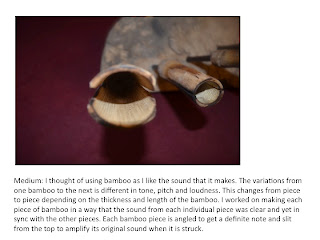Let me begin by saying that this class to me was not rendering a perfect new object, I agree it was that but it was also much more about experimentation. Of breaking form, ideas and i'm guessing various forms of discipline.And this is not an excuse for the instrument I will present tomorrow though a lot of people may think so, no, this was in a way my learning and thought process.
Son of a Gun, Number 1
We began this course with a simple assignment, easy but with a limitation, what could one do with a pet bottle in order to make an instrument. I blew it off til the last possible minute. Finally the instrument I presented was a set of seven bottles of various sizes. strung together. Rather really deftly taped together after tuning, not the work of a genius I know but that's the thing being creative and being original is about as close to impossible as someone can get.
Another thing, I was strongly averse to using strings in any of my instruments, because well most people I know are string people. Plus percussion is fun.


Killing You is Number 2
The second assignment was to remake your version of a wind chime/instrument. So what I did was use "Jugaad" and strung together bottle caps at varying heights, attached to a drain pipe. Again I had the same difficulty of breaking out of the stereotypical form of a wind chime itself. Therefore I made up for it with the aesthetic aspect of the instrument. (At least that's what I think.)
Final-lee in comes Number 3
The final instrument had me stumped for longer than I wish to remember. Soon enough though, in came my idea shinning like a knight in armor. *Drum roll*
So my idea was to create a wind instrument, like a pan pipe, based on the same principle, but with the air column substituted with a water column. Now the idea that formed in my head took over like a fever. (I could get extremely famous if that happened.) So I researched and came across the water piano, it was by far the coolest instrument I saw through the duration of this course.
Therefore I decided to make my own adjustment to a water piano and render the idea. Well needless to say my idea fell flat on its face (and mine if you come to think about it). In the end the instrument which I presented was a set of pan pipes. That works surprisingly well. Though the outcome was nothing new, or great, I did learn the mathematical equations involved in getting the sound right in the pan pipes. (And opposed to how you might be thinking right now, It was a LOT of work.)
Son of a Gun, Number 1
We began this course with a simple assignment, easy but with a limitation, what could one do with a pet bottle in order to make an instrument. I blew it off til the last possible minute. Finally the instrument I presented was a set of seven bottles of various sizes. strung together. Rather really deftly taped together after tuning, not the work of a genius I know but that's the thing being creative and being original is about as close to impossible as someone can get.
Another thing, I was strongly averse to using strings in any of my instruments, because well most people I know are string people. Plus percussion is fun.


Killing You is Number 2
The second assignment was to remake your version of a wind chime/instrument. So what I did was use "Jugaad" and strung together bottle caps at varying heights, attached to a drain pipe. Again I had the same difficulty of breaking out of the stereotypical form of a wind chime itself. Therefore I made up for it with the aesthetic aspect of the instrument. (At least that's what I think.)
Final-lee in comes Number 3
The final instrument had me stumped for longer than I wish to remember. Soon enough though, in came my idea shinning like a knight in armor. *Drum roll*
So my idea was to create a wind instrument, like a pan pipe, based on the same principle, but with the air column substituted with a water column. Now the idea that formed in my head took over like a fever. (I could get extremely famous if that happened.) So I researched and came across the water piano, it was by far the coolest instrument I saw through the duration of this course.
Therefore I decided to make my own adjustment to a water piano and render the idea. Well needless to say my idea fell flat on its face (and mine if you come to think about it). In the end the instrument which I presented was a set of pan pipes. That works surprisingly well. Though the outcome was nothing new, or great, I did learn the mathematical equations involved in getting the sound right in the pan pipes. (And opposed to how you might be thinking right now, It was a LOT of work.)

















































